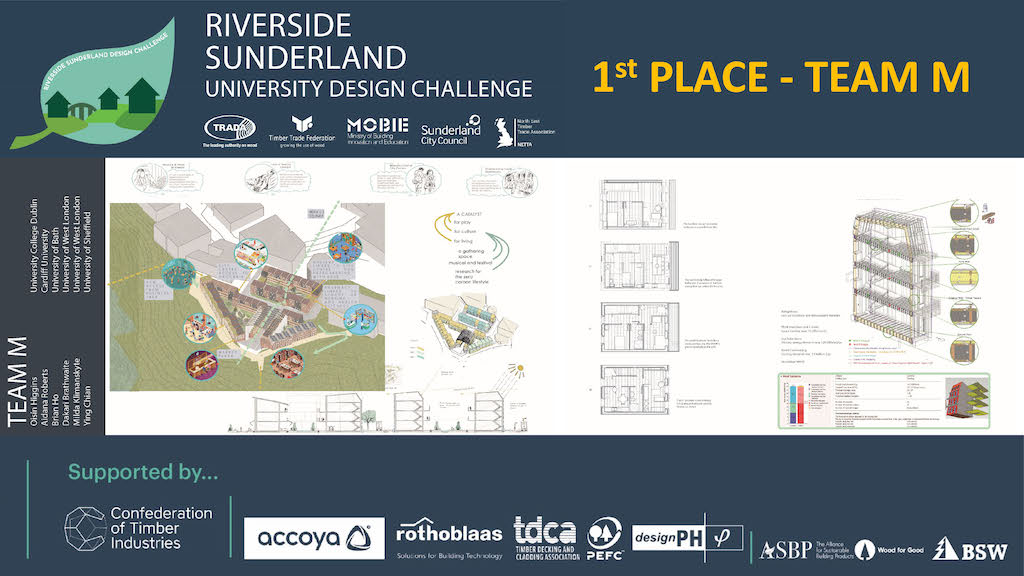
The winners of the Riverside Sunderland University Design Challenge (#RSUDC21) have been announced following an incredibly competitive six-month event.
From a group of more than 300 students from 39 universities and 27 interdisciplinary teams, the winners of #RSUDC21 were selected following a live event where students presented their projects to a panel of expert judges representing the best of UK construction.
#RSUDC21 encouraged students to design, engineer, plan and cost a three-bed family home along with an indicative masterplan for 100 homes which meet RIBA2030 Climate Challenge targets.
Students from across the UK were invited in this competition to collaborate, innovate, and create future-facing designs which reimagine how residents might live, work, and play together in beautiful, low-carbon, and multi-generational housing.
Designs from the teams included landscapes and streetscapes with green and open spaces against the backdrop of Riverside Sunderland, and also use low-carbon materials with timber and timber-hybrid systems the main material focus of #RSUDC21.
The judges felt that the standard of entries was exceptionally high and that all of the teams excelled in creating designs that connected with the history and ambition of the area, and imagined how modern methods of construction and inclusive design would deliver a truly sustainable community.
While picking winners was incredibly difficult, we would like to extend our congratulations to the following teams:
Highly Commended – Team R: Andrew Spence, Teesside University; Casling-Andoniou, Teesside University; Sarah Warrick, Teesside University; Lauren, Teesside University
Highly Commended – Team I: Boyang Xu, University of Sheffield; Hang Xu, University of Sheffield; Shen Zhekai, University of Sheffield; Weilin Lai, University of Sheffield; Xiao Han, University of Sheffield; Ziyu Li, University of Sheffield.
Neil Guthrie, Development Director (Residential) of Sunderland City Council: “Team I really considered the role of materials, of construction, including assembly and disassembly, amongst other technical aspects, while designing desirable homes which form a community. The methodologies and the way they sought to bridge their own knowledge gaps of the UK market was incredibly impressive to the judges.
“Team R in their presentation really pushed the boundaries with their concept of a village in the city, and their passion was evident. The scheme looked deep into the history of the city, bringing to life the traditional industries of shipbuilding and glassmaking into their scheme, these new communities, and the spaces they aimed to create.”
4th placed winner – Team D: Ananth Balakrishnan, Cardiff University; Joseph Meehan, University of Bristol; Mohammed Numaan Amar, University of Birmingham, Tsveta Karagyozova, University of Sheffield.
Mark Farmer, CEO and Founding Director at Cast Consultancy: “This entry stood out through its considerations of the technical detail. We work in a practically led industry, and this team showed they knew this through their attention to such matters as delivery logistics including the size of CLT panels and how they could be transported to site without needing lorry escorts. In addition there was real effort applied to optimising sourcing strategy and the use of local supply chain, as well as consideration of disassembly and the circular economy. It was a really strong entry from a multidisciplinary team which spanned four universities, showcasing the power of collaboration, and an array of future talent for the industry.”
3rd placed winner – Team B: Callum Hewitt, University of Liverpool; Daniela Lopez Pardo, University of Gloucestershire; Jade Biado, University of Bristol; Kyle Henderson, Robert Gordon University; Madeleine Clarke, Coventry University; Samuel Briar, University of Bath; Zaleekha Iqbal, University of Gloucestershire, Freya Noonan, University of Bristol.
Kelly Harrison, Associate Director of Whitby Wood: “The community focus and detailed consideration of the structure really stood out to us in this entry, with a lot of work going into the engineering, as well as the carbon costing of the project. Excellent attention was given to every technical detail which we could expect. The inclusion of a project manager was great to see and was evident with the inclusion of planning documents and minutes from all the meetings, showing an impressive level of work.
2nd placed winner – Team A: Elenor Naraidoo, University of Bath; Fathimath Ema Ziya, University of Bath; Heba Tabidi, University of Bath; Scott Thompson, Northumbria University; Sophie Whinney, University of Bristol, Wendy Young, University of Sheffield.
Dr Gemma Jerome, Director of Building with Nature: “This team made landscape the driving factor in their design, with the architects and landscape architects working side by side with engineers, surveyors and the rest of the profession to make sure landscape was not an afterthought, but integral to the scheme. Streetside trees are used as part of the drainage systems, and natural spaces are made to be inclusive, accessible and enjoyable – making the most of the riverside ecology.
“The landscape focus was evidenced throughout the masterplan which looked right down to the detail of the salt runoff from the roads and what plants will best suit this environment. This meant attention to landscape was not just an aspiration but seen as vital to the wellbeing of the residents, the wider community, and those in future, with a view to how this site will appear in ten years, twenty years, or even in two generations.”
1st placed winner – Team M: Aidana Roberts, Cardiff University; Brian Cheuk Yan Ho, University of Bath; Chian Ying Xuan, University of Sheffield; Dakari Brathwaite, University of West London; Kersten Chandy Mathew, Cardiff University, Milda Klimanskyte; University of West London, Oisin Higgins, University College Dublin.
Andy von Bradsky, Head of Architecture with MHCLG: “We felt this scheme was a comprehensive response to all senses of the brief. We were really excited to the commitment to the sense of place and community, with an aim to create a place which would be a gem in the future of Sutherland. It really understood the context, the wider area, even looking to how it may compensate for lack of facilities elsewhere in the city to be not just satisfying for the people who live there, but a place to visit for the wider area.
“The design considers the riverside location to enhance the environmental, social and design value for their communities and comprehensively addresses the technical, landscape and carbon aspects of their house and masterplan, making this scheme almost buildable. It would give real design teams a run through their money.”
Patrick Melia, Chief Executive of Sunderland City Council: “At the start of the programme I challenged the student community to inspire us with modern, aspirational, low carbon and integrated designs for the new homes and community on the Vaux site. You certainly didn’t let us down and we were absolutely astounded by the quality, flair, and diversity of the entries we received.
“Sunderland City Council really wants to provide the best homes and the best communities for its residents, and through challenges like this we hope that we can inspire young people to influence the future of our city and pursue careers and best practice in the housing and construction industry.”
David Hopkins, Chief Executive of Timber Development UK: “These students are showcasing some of the incredible talent coming out of UK universities, as well as the possibilities of working with timber. Solving the climate challenge is going to require both. We need people equipped with the knowledge to build low-carbon, and the technology and know-how to do so.
“In this competition the students are demonstrating that both the talent and technology already exists. We can build net zero now with timber, and we can build better, as these designs have shown. A huge congratulations to all of our winners, and to all participants who will without doubt benefit from this learning experience.”
Mark Southgate, chief executive of MOBIE: “The brief of the Riverside Sunderland University Design Challenge, to design a low carbon home and neighbourhood, was very demanding, as were the times the challenge took place in. To see how well these multidisciplinary teams of students, sometimes from different universities, came together virtually to produce complex design solutions and masterplans was amazing. The quality of the work they produced was nothing short of outstanding.
“Taking on the climate and housing crises is incredibly important and our built environment is key to creating a more sustainable future. Based on the quality of the entries from these talented young people I have no doubt that we have the individuals with the ideas, creativity and skills to help us address these crises head on. It has been inspirational to see the future thinking designs that the teams have created and I am delighted that MOBIE, Timber Development UK and Sunderland City Council have given them the opportunity to show off their undoubted talents to a wider audience.”
The Riverside University Design Challenge (#RSUDC21) came together through the combined efforts of Sunderland City Council, Timber Development UK (TTF and TRADA), and MOBIE. All entries to the competition are viewable on the Confederation of Timber Industries website.
We would like to extend a special thanks to our sponsors who have made RSUDC21 possible. This includes the Confederation of Timber Industries, Accoya, Rothoblaas, Timber Decking and Cladding Association, DesignPH, PEFC, Alliance for Sustainable Building Products, Wood for Good and BSW.https://labmonline.co.uk/








